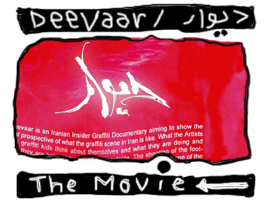KS Interview with Street Crew


ترجمه فارسی این مصاحبه را اینجا بخوانید
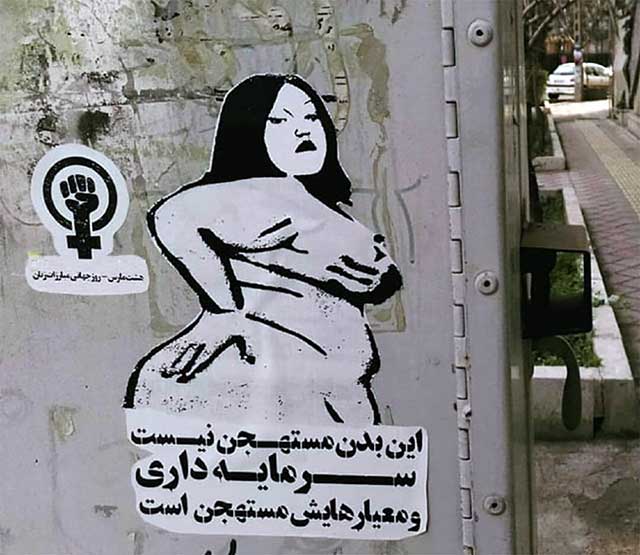
Text: This body is not obscene; Capitalism and its aesthetic values
are obscene. | Figure Motif : Moss.toc
Question: In another interview, you had pointed out that the indie or underground media may already be doomed to failure and prove ineffective against the mainstream media. In the other hand, graffiti art as the art of “claiming the city walls” or “public spaces” has the very same goal. Thus many street-artists complain about the misinterpretation of their work, or even doubt if their works would be effective anymore.This might be due to the fact that the cultural-hegemony and consumption patterns are all in-line with the authorised propaganda. What do you have for us in this regard?
Answer: Look, such an outlook contains a contradiction within itself; a contradiction in which lies the very answer. It is true that the ruling religious, capitalist state-apparatus, through its grasp on economic resources, media, educational institutions and even its approved family norms, is determining citizens’ values, lifestyles and consumption patterns. But, at the same time, there are mounting daily struggles proceeding underneath the society’ veneer of calm.
A “class-blind” art does not see these struggles. It sees “artist” as a member of the enlightened elite, surrounded by religious, consumerist and dumb masses not brainy enough to understand their art! But, on the contrary, such artists- be it a gallery artist or a street artist- do not realize to what extent they are themselves just cogs in the ruling state-machine.
Such “artists” do not see how capitalism, via its mental/physical division of labor, has made their “art” a special career and has isolated them from social dynamism; That is this social isolation that makes them look down on ordinary people. If these arrogant professional artists had to work unpleasant jobs in order to survive and had to go on strike for back pays, if they were reproached by the boss and summoned by security guards, if they were shot in protest against rising fuel prices, then they would have seen “courage” and “struggle” instead of just “passivity” and “dumbness” in society.
We are opposed to this kind of “street art” that is incapable of communicating with, for example, a worker rushing early in the morning to take a bus and get to work, or incapable of reaching out to a stay-at-home mum. In other words, a street art must not be an elitist art.
That is why we see “graffiti art” not separated from, but alongside daily social struggles. Even the name we have chosen for our campaign is a reflection of this attitude (Street: A tribune for political prisoners).
Let us close on a different note. If, as some may claim, graffiti as a form of protest has been really ineffective on people, the governments would not have gone to great length to fight it. Let us give you an example of our own experience. After pro-government forces had filled public-facing walls with Qasem Soleimani’s graffiti, we defaced them by adding horns and writing “the butcher of Syria & Iraq!”. This went viral on social media to such an extent that, for the subsequent couple of months, the pro-government cyber accounts were systematically busy trolling us furiously; as if their costly propaganda machine for Soleimani had now belittled by a tiny spray can! Obviously, their frustration was not from a defacement itself, but from the powerful echoes of Syrian and Iraqi protesters whose voices found their way into Iran, through a spray nozzle.
Question: Interesting! thanks for your answer. The fact that the socialist validity of art, relies basically on its ability to serve the class struggle or to reject its spook elitist definition in devision of labour, is ofcourse of an important concern. Also, the second part of your answer about your counter-propaganda campaign is remarkable, as the authorities always seek to eliminate any sign of discontent. By asking the previous question, I did not mean to say graffiti is ineffective at all, since, at Kolahstudio, we consider graffiti art as having no function but to clamor.
Don’t you think there are just a few among the masses who believe in the necessity and, after all, the possibility to change the status-quo? I mean, today, under the influence of mass media and entertainment industry, and in a world where rebellious-art is reduced to Banksy’s, don’t you think that people will feel disturbed or anguished by your works, rather than being agitated or awakened?
Answer : If there was actually no desire for making a better future, we definitely would not have witnessed mass uprisings of 2017-18 and 2019-20. You may have heard the proverb saying, “a hungry belly has no ears,” meaning that you cannot satisfy your hunger by “entertainment,” TV, etc.
Mass uprisings are worldwide and not peculiar to Iran; because “crisis” is an inextricable part of world capitalism. Under such crisis-ridden conditions, a graffiti work will be able to draw people’s attention so long as it addresses the real social issues they are struggling with. But whenever an artist intends to protest, they must immediately ask themselves: Protest against what? In favor of whom? with what perspective?
You made mention of Banksy, but we have even more examples of “protest art” that have been absorbed and seized on by the system. We are living in a society where the popular hatred of the status quo is too deep, so that even “tabloid celebrities” in their seek of popularity pose as dissidents and critics of the state of affairs. It is no coincidence that an establishment cartoonist like Bozorgmehr Hosseinpour, with his fascistic tendencies shown in support of the sterilization of the homeless (!), has recently created a so-called “protest” painting about the natural and social disasters of the past year. You see, it is no hard task to simply “protest” and “criticize”!
So, we are right to be suspicious about any “protest art” that recognizes, justifies or depends on the ruling class and its existing social order. How is it that Banksy regards himself as an anti-establishment artist and critical of art commercialization, but, simultaneously, has been not just tolerated, but approved, idolized and even monetized by the same establishment and art market? We have to be dubious and ask why his satirical painting, “Devolved Parliament,” depicting the British parliament populated by chimpanzees, sold for $12 million at an auction? Why are the rich, real-estate developers and art brokers interested in him, making a fortune from his artworks? and so on. As you see, being a street artist or a “protest artist” does not necessarily prevent you from becoming part of the art market, or of the system itself.
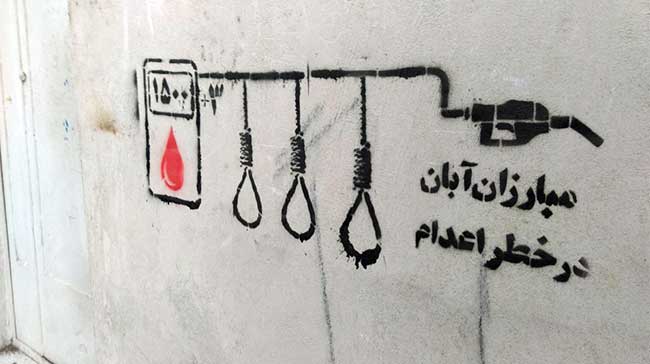
Text: The brave demonstrators of the 2019-20 uprising are under the threat of imminent execution.
Question: Graffiti is generally known as an art of rebellion. It also stands against the mural culture or legal/commissioned wall paintings. It seems to me that what you actually do is a form of graffiti which, through its stark messages, stands against the conventional graffiti of our time. In other words, it mimics the very contraposition between graffiti and murals and applies it in relation to Graffiti itself.
Answer : You are correct on the differences between murals and graffiti. The former is mostly painted with permission in return for money, but the latter is called “vandalism” by governments and the artist may end up in jail or with financial charges.
If you feel that our artworks stand somehow in contrast to graffiti as such, it may be because we are not “a graffiti writer group” in the fashionable sense of the word. We define ourselves, first of all, as a socialist opposition group which uses graffiti art as a means of communicating with the audience. That is why we do not concern ourselves with “tagging,” “throw-ups” , etc. There have been three factors which make the political aspect of our works predominate the artistic side: the agility and promptness, the political explicitness, and the aim of communicating with the broader public. So, the fact that our works are more political than artistic may answer why you feel they are not “graffiti” as such.
Question: I think there has to be some misunderstanding. Just to make it clear, I should add that, according to graffiti writers, Murals are just a part of the System. In such a sense, according to you, Graffiti writers, maybe unintentionally, play within the System, right?
Answer : Yes, this is what we meant, i.e., just because art is in the streets does not automatically make it radical, progressive and anti-establishment.
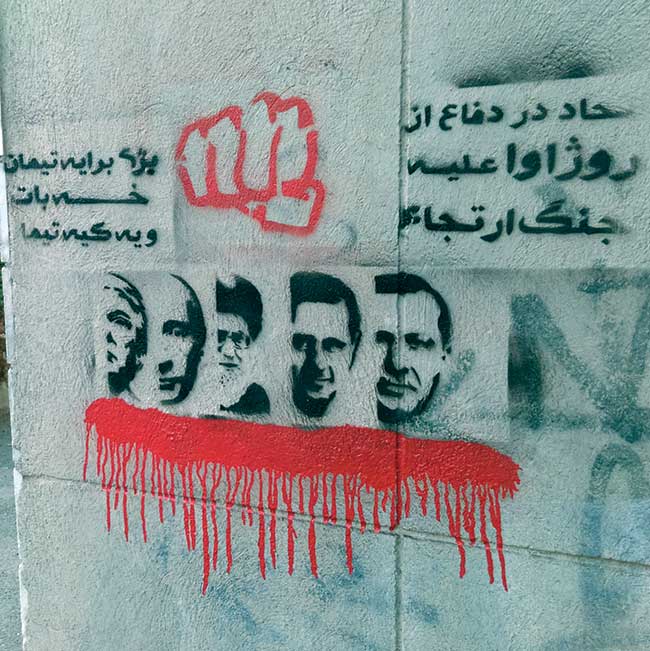
Text: Unity in defense of the Rojava Resistance and against the regional and world powers’ reactionary wars in the Middleeast.
Question: In the past decade, Iranian graffiti arena faced a rise in the appearance of formalistic or conspicuous graffiti. The content of these works is kind of hospitable to the market and authorities. How do you avoid this happening to you?
Answer : The more unclear, wishy-washy and neutral your graffiti, the more easily will it be seized on and misused by the powers that be. It is, therefore, necessary to draw a clear line between yourself and the ruling powers. But it rarely happens that an artwork can be a comprehensive “manifesto” in itself. There have been, therefore, some cases where the mainstream media, according to their political agenda, have cherry-picked and displayed some of our works.
One of our most painful experiences was when the Farsi twitter account of Israeli government, as a rabid military regime in the Middle East, published our defaced graffiti of Soleimani, calling it “plain truth.” On that occasion we really lost our temper to such an extent that we were considering to go back again and spray Netanyahu’s graffiti with the slogan “the butcher of Palestine” alongside Soleimani’s; However due to the location of that defacement being in front of a Basij headquarter and its subsequent security risk, the suggestion was eventually voted down.
On a related note, however, some months before this, at a time when the regime had brutally cracked down the city of Mahshahr during the 2019-20 uprising, we made a stencil reading, “Khamenei & Netanyahu: Two Soulmates.” This idea was inspired by watching footages of the unarmed people of Mahshahr who, wearing worn-out slippers and throwing stones, were fighting against armored vehicles. Its resemblance to the Palestinian Intifada was astonishing. So, we took it as an opportunity to kill two birds with one stone and expose both Iranian and Israeli regimes and show how they are the same in essence. Obviously, no mainstream media were inclined to cover the graffiti at the time.
Question: You just stated that, the more unclear and neutral the work of art is, the more easily will it be seized on and misused by the authorities. In other words, it is the self-censorship or self-neutralization that disarms the graffiti and drains it from any kind of political function. To put it in another way, the artist castrates their own work of art. Thanks for mentioning this important demerit. And do you think this originates from a kind of conformism, hypocrisy or foxiness?! and do you have the same idea about the politically-conscious music?
Answer : Far more than an artist’s “hypocrisy,” it is about the dominant culture, functions and criteria of establishment art. The class content of art, the lucrative industry behind modern art, and its apologists/hirelings (editors, art critics, art brokers, etc.) are among the major factors usually overlooked.
Graffiti is merely a form of communication, its content might be commercial, a mish-mash of teenage bickering, purely abstract, or even great humane concepts. We are not trying to dictate “what” this content must be and “for whom”. An artist may want to create an artwork which is merely a reflection of his/her mood, but does so in the most talented and innovative way that will move the boundaries of art further! We are not saying those artworks are unimportant, or that one should be removed in favor of the other. It is absurd, for example, to claim that between Tarkovsky’s and Ken Loach’s cinemas, one should be eliminated in favor of the other. However, we do say that only one of the two is considered a “people’s art.” As it is obvious that Tarkovsky’s film language is not in layman’s terms.
In the same vein, our question here has not been graffiti in general, about a specific kind of graffiti whose aim is “social change” and whose audience the “masses”.
As for the protest music, though we are not expert on that, but our general argument about the class content of art, the notion of people’s art and its social aims is applicable to all forms of art.
Question: One of the reasons I really appreciate your works is that you crash-dive into the profound origin of graffiti, where the very majority of us who call ourselves Graffiti Writers can’t even dream of. In doing so, you have had to learn a handful of tactics e.g to fight,function and hide. So, instead of hiding your message, your choice has been to spread your message as a hidden messenger. What do you have to say about this?
Answer : As mentioned above, we are first and foremost a political socialist group. So, if arrested, we will probably be charged with more indictments than those for mere “vandalism.” For that reason, observing the secrecy and security protocols is a matter of life and death for us, and the only guarantee of our activity permanence.
For an individual graffiti writer who works single-handedly and does not cross the red lines, such an obsession over security issues may not seem that necessary, knowing that he/she is in no serious jeopardy and in the worst-case scenario may end up in jail for, say, a couple of days. But the more organized, durable and radical a group, the more resolute will the government become in chasing it.
Well, when you are faced with such a repressive system, there will be only two options before you: either self-censor yourself or master underground activity. We have chosen the latter. It may be strange to you to hear that we have members in this group who have been working shoulder to shoulder, but know nothing about each other more than their pseudonyms. This is in order that the group as a whole can survive in the event that a member gets arrested. Of course, this is not something we have invented, but it is the gist of all historical experiences in revolutionary struggle passed on to us.
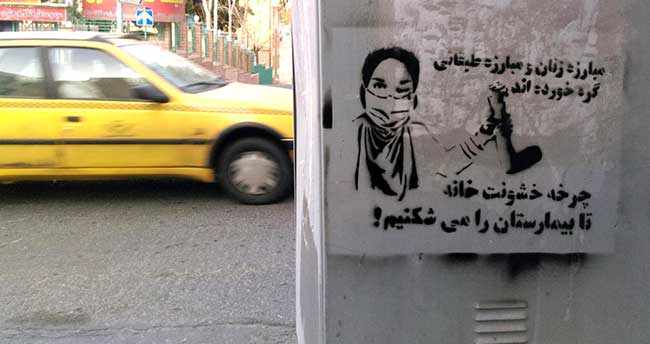
Question: If I ask you to leave a message for the youth who invest a lot of money and time in graffiti scene, painting in water canals or abandoned buildings, what would it be? and how would you justify your own approach?
Answer : Look, in the final analysis, it all depends on a person’s class status and social environment. There are graffiti writers coming from affluent layers of society, having no financial concerns. Graffiti art, for them, is mainly an outlet of excitement. At the same time, there are others looking for making money from this activity and dreaming of international fame by taking part in big festivals or exhibitions. When you take a look at the artworks of the both, you find them far too formalistic, hardly having any serious political or social point at all.
We have no message for these groups for whom political and social issues are of no priority, but do have for those who regard social and political content as inseparable from graffiti.
A graffiti writer who has spent a lot of time, taken security risks, gained skills and leveled up should at some point ask themselves: “So what? What am I looking for? Repeating myself? Personal reputation? Or devoting my time and expertise to helping people in their struggle against the system?”. If the latter is the case, then they must be self-confident that their art can be a sharp weapon in the struggle against capitalism.
Thus, our first message is that: If you want to cross the red lines and to guarantee your long-run activity, strictly conceal your identity (even from other graffiti writers). Secondly, abandoned houses in ruins and bridge pillars are suitable places for practicing, but if confined to them, graffiti will lose its function as an urban and street art.
The other point is that, just because graffiti is done in the streets does not still make it “people’s art”. To find a way to communicate with the public in layman’s terms must be achieved through patience.
Forty years of pent-up anger in Iranian society has made this country a tinderbox, so there is an abundance of subjects for objection- enough to stretch out your hand and pick up one! But to avoid being disheartened after a few months, you should already have cleared the air with yourself. It is not enough to be a dissident in Iran, one should be a fighter in order to survive. This is not of course peculiar to Iran but to the world. Many graffiti writers around the world who protest against war, environmental disasters, fascism, racism, etc. are at the same time political activists and do not have a one-sided and purely artistic life.
As a result, our message to our fellow graffiti writers inside Iran is that you need to use your time, energy, resources, creativity, and skills in a way that infringes the prevailing graffiti norms and has tangible political/social effects; that you do not have to confine yourselves to mere techniques or to just describing social sufferings at best; that try to figure out the root causes of all these human sufferings, to politically and historically analyze the outmoded socio-economic system, namely capitalism, which has been breeding crises one after another all over the world; that try to go further than just narrating social adversities and to have something new to talk about with passerby.
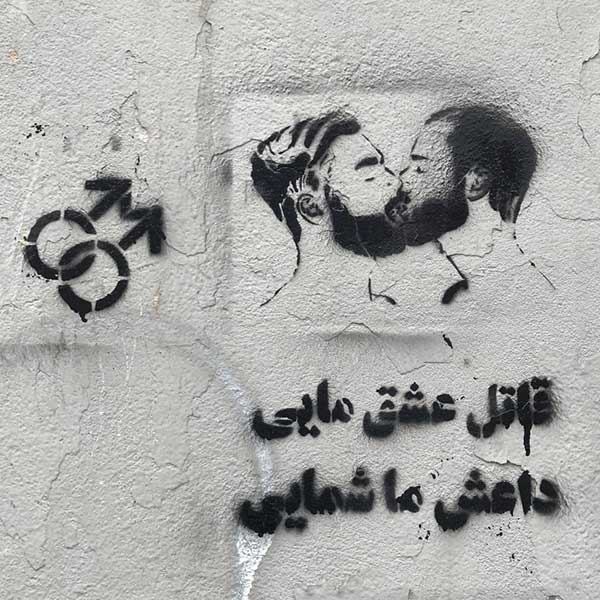
Text: You are the murderer of our love , You are our ISIS
Question: You also apply Images in your graffitis. Why don’t you leave the imagery aside, as did the International Situationists’ group, and focus on naked written messages?
Answer : Our differences with the “International Situationist” (IS) are far more than the question of artistic techniques or styles. The IS, as a political group of left-wing artists, was active for 15 years, the culmination of which was during the May 68 student uprising in France. At the time, the IS could intervene in those events via its supporters among students, artists, and the intelligentsia. There appeared and spread slogans mainly on the walls of Paris, which were either direct quotes from IS writings or influenced by them, like the famous one “Be realistic, demand the impossible!”. The most favored technique the IS used to apply was called “détournement”, that is to say, turning slogans and logos against the advertisers or politicians.
As far as this group promoted “political art,” and insisted on “political action” against the capitalist system, you can find similarities between them and us. But our differences are more fundamental.
The IS was an offshoot of the “New Left,” a current which actually had no belief in the revolutionary potential of the working class (no matter how many times the words “working class,” “council,” “revolution,” etc. were referred to in their writings) but they rather saw workers as a backward mass fully integrated into capitalist society via consumption and the media, consequently not able to be a revolutionary driving force. So, in this view, the task of “revolution” was assigned to the intelligentsia, responsible to wake up this asleep working class; and thus, the class struggle was replaced by “critical thinking” and the aim of revolution was reduced to some cultural changes.
In the view of Situationists, society was a passive spectator that had been drugged by the media, and it was on the radical artists to shake it up through “provocative actions” (a term repeated too many times in their writings).
But, on the contrary, we see the arena of class struggle in a very different way. In our view, workers and the oppressed are not asleep and their daily struggles are rich and bold.
The conclusion of IS’s elitist views is nowhere best reflected than in the destiny of its leaders and supporters. Guy Debord (author of “The Society of the Spectacle,” regarded as the manifesto of IS) ended up with alcoholism, isolation in remote intellectual circles, and finally suicide. Rudi Dutschke, a student leader and member of the German branch of the IS, reached to a highly illusionary, reformist theory, to the effect that by taking positions in the state, socialists can undermine the state from within and set conditions for revolution! Daniel Bendit, as known as “Dany the Red,” who was once a prominent student leader in the May 68 uprising in France, turned his back on the ideals of his youth and became a member of the EU parliament for 20 years. Joschka Fischer, a close friend and political disciple of Bendit, transmuted from a street protester to Germany’s foreign minister! In short, all those seemed to be anti-establishment, became part of the establishment themselves.
Question: Technically talking, other than spray writing, you have already employed stenciling technics as well as wheat-pasting or postering. This may help you in terms of agility and timing, but isn’t it reducing the main subject of discontent?
In addition, in such a way, you seem more like an organised political group… would you tell us more about this?
Answer : So far, we have used a variety of techniques, from hanging banners, pasting stickers and posters to writing slogans and spraying stencils. The last one is our common technique, because it is easy-to-use and quick, with a long-lasting result, making us able to do mass graffiti works.
There is no doubt that the technical, aesthetic and artistic aspects of our works are insignificant. In some cases, we have just altered and then used the ready-made designs found on the internet. This is, before anything, because of the lack of time and resources.
In response to the second part of your question, our answer is yes. There is a same set of thoughts and positions behind all of works. We are not simply critics of the status quo, but also advocates of a radical alternative to it. That is why, in addition to our defensive tasks toward political prisoners, this campaign also attempts to propagate programmatic anti-capitalist LGBT community, etc. and to express solidarity with the regional and international struggles as well.
…Thank you .
…Thanks for having us.
Instagram Page to Follow https://www.instagram.com/khiabantribune/

